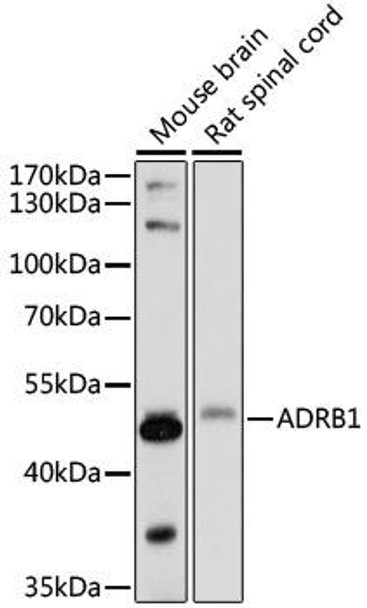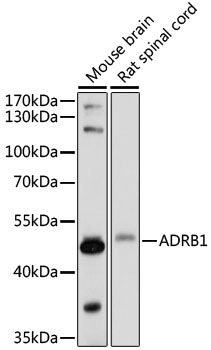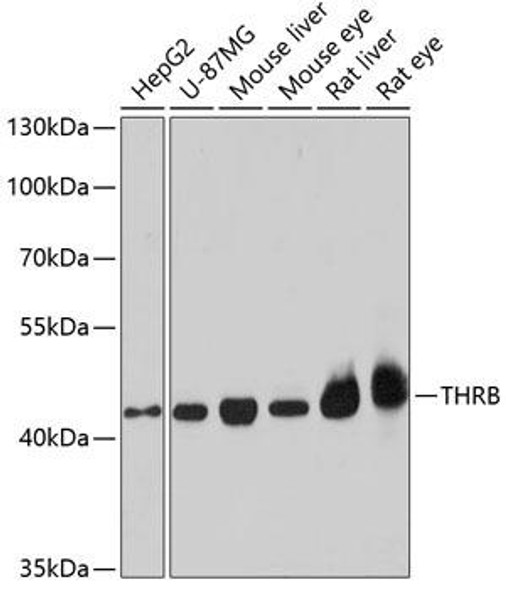Description
Anti-ADRB1 Antibody (CAB16334)
The ADRB1 Polyclonal Antibody (CAB16334) is a valuable tool for researchers studying ADRB1, a key protein involved in regulating heart rate and contractility. This antibody, produced in rabbits, has high specificity for human samples and has been validated for use in Western blot applications. By binding to the ADRB1 protein, this antibody enables the detection and analysis of ADRB1 in various cell types, making it an essential tool for research in cardiology and cardiovascular diseases.ADRB1, also known as beta-1 adrenergic receptor, plays a crucial role in regulating the cardiovascular system by responding to adrenaline and other stress hormones.
Dysregulation of ADRB1 activity has been linked to heart failure, arrhythmias, and other cardiovascular disorders. Therefore, understanding the function of ADRB1 is essential for developing novel therapies and interventions targeting these conditions. The ADRB1 Polyclonal Antibody (CAB16334) provides researchers with a reliable and sensitive tool for investigating the role of ADRB1 in health and disease.
| Antibody Name: | Anti-ADRB1 Antibody |
| Antibody SKU: | CAB16334 |
| Antibody Size: | 20uL, 50uL, 100uL |
| Application: | WB |
| Reactivity: | Mouse, Rat |
| Host Species: | Rabbit |
| Immunogen: | A synthetic peptide corresponding to a sequence within amino acids 150-250 of human ADRB1 (NP_000675.1). |
| Application: | WB |
| Recommended Dilution: | WB 1:500 - 1:2000 |
| Reactivity: | Mouse, Rat |
| Positive Samples: | mouse brain, rat spinal cord |
| Immunogen: | A synthetic peptide corresponding to a sequence within amino acids 150-250 of human ADRB1 (NP_000675.1). |
| Purification Method: | Affinity purification |
| Storage Buffer: | Store at -20'C. Avoid freeze / thaw cycles. Buffer: PBS with 0.02% sodium azide, 50% glycerol, pH7.3. |
| Isotype: | IgG |
| Sequence: | CVIA LDRY LAIT SPFR YQSL LTRA RARG LVCT VWAI SALV SFLP ILMH WWRA ESDE ARRC YNDP KCCD FVTN RAYA IASS VVSF YVPL CIMA FVYL RVFR E |
| Gene ID: | 153 |
| Uniprot: | P08588 |
| Cellular Location: | |
| Calculated MW: | 51kDa |
| Observed MW: | 51kDa |
| Synonyms: | ADRB1, ADRB1R, B1AR, BETA1AR, RHR |
| Background: | The adrenergic receptors (subtypes alpha 1, alpha 2, beta 1, and beta 2) are a prototypic family of guanine nucleotide binding regulatory protein-coupled receptors that mediate the physiological effects of the hormone epinephrine and the neurotransmitter norepinephrine. Specific polymorphisms in this gene have been shown to affect the resting heart rate and can be involved in heart failure. |
| UniProt Protein Function: | ADRB1: a GPCR-coupled 7 transmembrane receptor that binds epinephrine and norepinephrine with approximately equal affinity. Mediates the catecholamine-induced activation of adenylate cyclase through the action of G proteins. Interacts with PIST and PSD-95. Localized at the plasma membrane and in the Golgi upon PIST overexpression. Homologous desensitization of the receptor is mediated by its phosphorylation by beta-adrenergic receptor kinase. |
| UniProt Protein Details: | Protein type:Membrane protein, multi-pass; Membrane protein, integral; Receptor, GPCR; GPCR, family 1 Chromosomal Location of Human Ortholog: 10q25.3 Cellular Component: early endosome; integral to plasma membrane; plasma membrane Molecular Function:alpha-2A adrenergic receptor binding; beta-adrenergic receptor activity; beta1-adrenergic receptor activity; epinephrine binding; norepinephrine binding; PDZ domain binding; protein binding; protein heterodimerization activity; Ras guanyl-nucleotide exchange factor activity; receptor signaling protein activity Biological Process: adenylate cyclase activation; brown fat cell differentiation; cell-cell signaling; diet induced thermogenesis; fear response; heat generation; negative regulation of multicellular organism growth; norepinephrine-epinephrine vasodilation involved in regulation of systemic arterial blood pressure; positive regulation of cAMP biosynthetic process; positive regulation of GTPase activity; positive regulation of heart rate by epinephrine-norepinephrine; positive regulation of the force of heart contraction by epinephrine-norepinephrine; response to cold; thermoregulation Disease: Resting Heart Rate, Variation In |
| NCBI Summary: | The adrenergic receptors (subtypes alpha 1, alpha 2, beta 1, and beta 2) are a prototypic family of guanine nucleotide binding regulatory protein-coupled receptors that mediate the physiological effects of the hormone epinephrine and the neurotransmitter norepinephrine. Specific polymorphisms in this gene have been shown to affect the resting heart rate and can be involved in heart failure. [provided by RefSeq, Jul 2008] |
| UniProt Code: | P08588 |
| NCBI GenInfo Identifier: | 48429211 |
| NCBI Gene ID: | 153 |
| NCBI Accession: | P08588.2 |
| UniProt Secondary Accession: | P08588,Q5T5Y4, Q9UKG7, Q9UKG8, B0LPE2, |
| UniProt Related Accession: | P08588 |
| Molecular Weight: | 51,323 Da |
| NCBI Full Name: | Beta-1 adrenergic receptor |
| NCBI Synonym Full Names: | adrenoceptor beta 1 |
| NCBI Official Symbol: | ADRB1 |
| NCBI Official Synonym Symbols: | RHR; B1AR; ADRB1R; BETA1AR |
| NCBI Protein Information: | beta-1 adrenergic receptor |
| UniProt Protein Name: | Beta-1 adrenergic receptor |
| UniProt Synonym Protein Names: | Beta-1 adrenoreceptor; Beta-1 adrenoceptor |
| Protein Family: | Beta-1 adrenergic receptor |
| UniProt Gene Name: | ADRB1 |
| UniProt Entry Name: | ADRB1_HUMAN |









